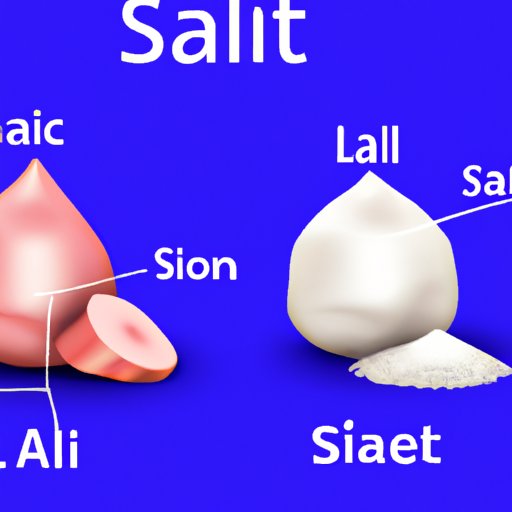Introduction
Chemistry is a fascinating branch of science that deals with the structure, composition, and properties of matter. Salts are one such matter that is an essential component of various chemical reactions. Understanding salts in chemistry is vital for students, researchers, and anyone curious about the chemical world around us.
Understanding salts in chemistry: a beginner’s guide
A salt, in chemistry, is the product of a reaction between an acid and a base. It is an ionic compound that consists of cations and anions held together by electrostatic forces called ionic bonds. Salts are formed by the neutralization of an acid and a base. The proton from the acid is transferred to the base, forming water, and the remaining cation and anion combine to form the salt.
There are different types of salts based on the combination of cations and anions. Some common examples include sodium chloride (NaCl), potassium nitrate (KNO3), ammonium chloride (NH4Cl), and calcium carbonate (CaCO3).
The science behind salts and their chemical properties
Salts have a crystalline structure and are usually solid at room temperature. Their solubility, melting point, and conductivity are essential properties that govern their behavior in different contexts. Salts can be soluble or insoluble in water, depending on the ionic size and the electrostatic attraction between the ions. For instance, NaCl is a highly soluble salt, while CaSO4 is relatively insoluble.
Salts have a high melting point, which indicates their strong ionic bonds. They conduct electricity when they are dissolved in water because they dissociate into cations and anions that can move freely in solution. However, solid salts do not conduct electricity because the ions are tightly held together in a crystal lattice.
The various types of salts and their industrial applications
Salts have various industrial applications, ranging from the manufacture of fertilizers to the refining of metals. Sodium chloride (NaCl) is a common salt used in food preservation, water softening, and de-icing of roads. Calcium sulfate (CaSO4) is used in the manufacture of cement and plaster of Paris. Ammonium nitrate (NH4NO3) is used in the production of fertilizers and explosives.
The production processes involving salts are often high-temperature reactions that require careful control of the reaction conditions to ensure purity and yield. For example, the manufacturing of fertilizers involves mixing sulfuric acid with ammonia gas to produce ammonium sulfate or ammonium nitrate. The refining of metals involves the use of various salts, such as potassium chloride (KCl) and sodium carbonate (Na2CO3), to extract impurities from the metal ores.
How salts are formed and their importance in chemical reactions
Salts can be formed in several ways, such as acid-base reactions and precipitation. Acid-base reactions involve the reaction of an acid with a base to form salt and water. Precipitation reactions occur when two aqueous solutions containing ions react to form an insoluble salt that precipitates out of solution.
Salts play an essential role in chemical reactions as catalysts, reactants, and products. For instance, metal salts are often used as catalysts in various chemical reactions. They can also be used as reactants in the synthesis of other compounds, such as in the synthesis of aspirin. In some cases, salts are also a product of a chemical reaction, such as the reaction between hydrochloric acid and sodium hydroxide to form sodium chloride and water.
The role of salts in everyday life: from food preservation to water treatment
Salts have a range of everyday applications and uses. Sodium chloride, or table salt, is commonly used to preserve food by inhibiting bacterial growth. It is also used to soften water and make it more palatable. Calcium chloride is used as a dehumidifier and desiccant and can help remove moisture from the air.
However, the use of salts in everyday life is not without drawbacks. For example, excessive consumption of salt can lead to high blood pressure, which increases the risk of heart attacks and stroke. The use of calcium chloride on roads can damage cars and infrastructure. There are also concerns about the environmental impact of salt disposal on lakes, rivers, and groundwater.
Exploring the benefits and drawbacks of using salts in chemistry experiments
Salts have various benefits when used in chemistry experiments. They can be used to control the pH of a reaction, increase reaction rates, and modify the solubility of compounds. Salts can also be used as buffers to maintain the pH of a solution.
However, the use of salts in chemistry experiments can also have potential drawbacks. Some salts can be toxic and can pose a health hazard if not handled properly. They can also contaminate samples and interfere with analytical measurements. Therefore, it is crucial to follow safety procedures when working with salts in the laboratory.
Conclusion
In conclusion, salts are an essential component of various chemical reactions and have several applications in our everyday lives. Understanding salts in chemistry is crucial, particularly for students and researchers working on chemical processes and reactions. With the knowledge gained from this beginner’s guide, one can better appreciate the role of salts in the world of chemistry and their significance in sustaining life.
